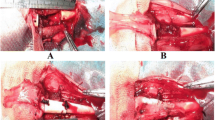The status of the microcirculatory bed in the skin in the bone regenerate projection was studied under conditions of fractionated automated tibial elongation by transosteal distraction osteosynthesis at a rate of 3 mm/day in adult mongrel dogs. Histological and physiological data indicated that the distraction period was associated with changes in the functional components of the skin microcirculatory bed. Active neovasculogenesis and formation of additional arteriovenular anastomoses provided sufficient oxygenation of tissues and maintained venous outflow. This led to rapid recovery of the functional potentialities of skin microvessels as early as 1 month after the end of forced fixation.
Similar content being viewed by others
References
V. V. Banin, Mechanisms of Inner Media Exchange [in Russian], Moscow (2000).
Yu. M. Ir’yanov, Genii Ortoped., Nos. 2-3, 132–133 (1996).
T. V. Kirilina, G. V. Krasnikov, A. V. Tankanag, et al., Regionar. Krovoobr. Mikrotsirk., No. 2, 59–62 (2009).
N. A. Klimenko and S. V. Tatarko, Bull. Exp. Biol. Med., 119, No. 3, 252–255 (1995).
S. A. Muslimov, Morphological Aspects of Regenerative Surgery [in Russian], Ufa (2000).
V. M. Chuchkov and O. A. Gelashvili, Morf. Vedomosti, Nos. 1-2, 70–71 (2006).
V. I. Shevtsov, L. A. Grebenyuk, and N. I. Gordievskikh, Meto dol. Fluometr., No. 6, 188–193 (2002).
A. B. Shekhter and V. V. Serov, Arkh. Patol., 53, No. 7, 7–14 (1991).
M. Benjamin and B. Hillen, Eur. J. Morphol., 41, No. 1, 3–7 (2003).
B. Fink, Orthopade, 28, No. 12, 1007–1014 (1999).
G. Pietramaggiori, P. Liu, S. S. Scherer, et al., Ann. Surg., 246, No. 5, 896–902 (2007).
M. B. Shvyrkov, Stomatologiia (Mosk.), 81, No. 3, 9–13 (2002).
J. H. Wang and B. P. Thampatty, Int. Rev. Cell. Mol. Biol., 271, 301–346 (2008).
Author information
Authors and Affiliations
Corresponding author
Additional information
Translated from Byulleten’ Eksperimental’noi Biologii i Meditsiny, Vol. 155, No. 2, pp. 224-228, February, 2013
Rights and permissions
About this article
Cite this article
Gorbach, E.N., Kononovich, N.A. Adaptation Capacity of Microcirculatory Bed of the Skin under Conditions of High-Frequency Rate Fractionated Automated Tibial Elongation. Bull Exp Biol Med 155, 255–259 (2013). https://doi.org/10.1007/s10517-013-2126-0
Received:
Published:
Issue Date:
DOI: https://doi.org/10.1007/s10517-013-2126-0




